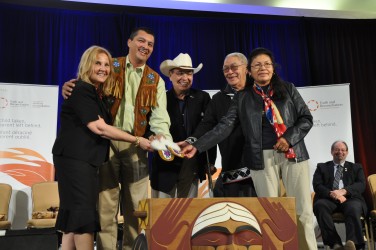Article Origin
Volume
Issue
Year
The Truth and Reconciliation Commission only recently released their final report calling for Canada-wide education on Indian residential schools, but two Canadian territories have been at it for a few years.
Nunavut and the Northwest Territories are the first in Canada to make the material mandatory for high school graduation, and the Northwest Territories has taken it a step further this year by mandating that all educators receive residential schools training before they can be certified to teach in the territory.
“We found the in-service helped teachers not just in teaching the residential school module, but in teaching all their other students because it changed their relationships, and their understanding of the community,” said Mindy Willett, social studies and northern studies coordinator for the N.W.T.
As of last February, all teachers in the province had received some form of training, but because the province sees a 10 per cent turnover in teachers yearly, newcomers posed a problem, said Willett. Minister of Education, Culture, and Employment Jackson Lafferty announced in the summer that training would be mandatory, so a special “New to the N.W.T.” training was held after new teachers arrived in the fall.
“With our new in-service, it’s critical they hear from former residential school students. We’ve adopted the Chiros blanket exercise. It’s a role play, narrated by an Indigenous person, and it helps teachers understand where residential schools came from... It’s a dramatic experience of colonization,” she said.
While the teacher training on residential schools is still a work-in progress, the N.W.T. is now in its second year of the material being mandatory for students, though it was piloted two years prior to that. It’s embedded within a larger course, and taught only at the Grade 10 level.
“In the Northwest Territories, we wanted to make sure it wasn’t in a course that kids chose. We wanted to call it Northern Studies, so that everyone was included because, you’ve heard many times, this isn’t an Aboriginal problem, it’s a Canadian problem,” said Willet.
When the N.W.T. first started looking into creating a residential school curriculum, the TRC was just getting fired up, said Willett. Elders, cultural leaders, language leaders, and political leaders from across the territory came together to act as a source of guidance for the development of the curriculum, she said.
At the same time, Nunavut was working with the Legacy of Hope Foundation—a non-profit committed to educating the public about the history of residential schools. The two territories and Legacy of Hope then banded together to form a three-way partnership, said Willett.
“As we developed the resources, we did interviews with former residential school students, so what you get is lots of audio and video of their experiences. That also advised us on who and what should be included in the process. By the time we did the second edition, we felt confident it was meeting the goals we set for ourselves,” she said.
Nunavut has gone a slightly different route, placing their residential schools lessons within Social Studies 10 rather than having a separate class like N.W.T.’s Northern Studies, said Ken Beardsall, curriculum coordinator for the Department of Education. But like the N.W.T., the topic fills an entire 25-hour module within a 125-hour course.
“It’s actually pretty big, the teachers would say it’s more than 25 hours of instruction... But it really goes well. In fact, one teacher was saying her attendance goes up for social studies because the kids enjoyed it,” he said.
Nunavut used most of the materials put out by Legacy of Hope, but adapted them to a northern context. Not only that, they’re also in the process of translating the entire course—including the module on residential schools—into Inuktitut, one of the territories main Indigenous languages, said Beardsall.
“When you translate something from English to Inuktitut, a lot of the culture from English is embedded in that language, and the terminology. So when you lead with Inuktitut… you’re embedding the culture of Inuit. We realized that’s a really good way to incorporate culture into the curriculum, and that’s one of the techniques we’ve practiced,” he said.
Though digging up the past can have its negative effects, and Beardsall is aware that some parents might be triggered by talking about some of their buried trauma with children who have just learned about it in school, that’s not the point, he said.
“In the end, the focus is not to leave people unhappy. The focus is on hope… The fact that we’re actually doing this and talking about it is going to make a better future, for all Canadians, really,” said Beardsall.
Photo caption: Minister of Education, Culture, and Employment in the Northwest Territories, Jackson Lafferty, presents teenage slippers (as opposed to baby slippers) at a Truth and Reconciliation Commission conference, symbolizing growth made in universal education around residential schools in the territory.
- 1926 views

